The Body's Slow Burn: How to Fight Chronic Inflammation (Inflammaging)
10/9/20256 min read

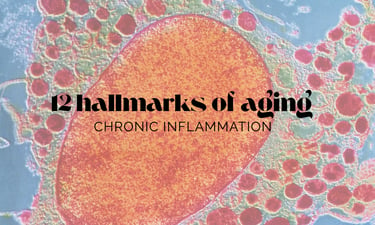
If you’ve ever had a cut that turned red and warm, you’ve witnessed inflammation in action. This is acute inflammation - a powerful, short-lived fire your immune system ignites to fight off invaders and heal damaged tissue. It’s a vital and healthy process. But what happens when that fire never truly goes out?
Welcome to the world of chronic inflammation, a hidden, low-grade fire that can smolder within your body for decades. Scientists have given this process a name: "inflammaging", and it's now recognized as a central Hallmark of Aging (López-Otín et al., 2023). This slow burn doesn't cause dramatic symptoms at first, but it silently damages your cells and tissues, creating the perfect environment for nearly every major age-related disease to develop.
This article is your guide to understanding this invisible threat.
The Science: Why the Fire Won't Go Out
Inflammaging occurs when the "off-switch" for inflammation breaks, leading to a persistent, body-wide state of alert. This chronic fire is fueled by several key drivers of aging:
Visceral Fat: Fat tissue, especially deep abdominal fat, is not inert; it's an active organ that pumps out inflammatory molecules called cytokines.
Gut Dysbiosis: An unhealthy balance of gut bacteria can lead to a "leaky gut," allowing bacterial toxins like LPS to enter the bloodstream and trigger a massive inflammatory response.
Senescent "Zombie" Cells: As we've discussed, these aging cells secrete a toxic, inflammatory cocktail known as the SASP, fueling the flames.
Chronic Stress & Poor Sleep: Both psychological stress and lack of sleep disrupt hormonal balance and push the immune system into an inflammatory state (Mullington et al., 2010).
This relentless, low-grade inflammation is the common soil from which the major diseases of aging grow, including heart disease, type 2 diabetes, neurodegenerative diseases like Alzheimer's, and arthritis (Ferrucci & Fabbri, 2018).
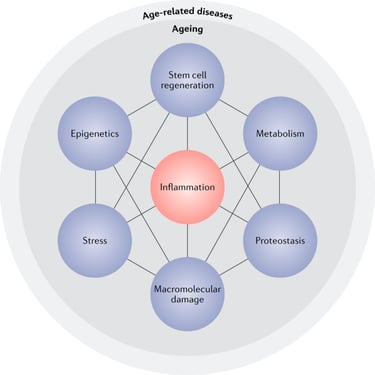

Most major diseases of aging, from heart disease to dementia, don't appear out of nowhere. They grow in the fertile soil of chronic, low-grade inflammation.
The Dashboard: Can You Measure Your Zombie Cell Load?
Yes. Unlike some other hallmarks, inflammation is one of the most well-established and easily measured biomarkers.
High-sensitivity C-reactive protein (hs-CRP): This is the gold standard. It’s a simple blood test that measures a protein produced by your liver in response to inflammation. While levels can spike during an acute illness, a consistently elevated level is a clear sign of chronic inflammation. For optimal health, most longevity experts recommend a level below 1.0 mg/L.
Other Markers: For a more detailed view, physicians may look at other markers like Homocysteine or specific inflammatory messengers like Interleukin-6 (IL-6) and TNF-alpha.


The Action Plan: Your Evidence-Based Toolkit
Quenching the flames of inflammaging starts with foundational lifestyle choices.
The Foundational Levers
Diet: The Anti-Inflammatory Plate. This is your most powerful tool. The goal is to remove inflammatory fuels and add soothing compounds.
Foods to Add: Focus on a diet rich in Omega-3 fatty acids (fatty fish, walnuts), polyphenols (brightly colored fruits and vegetables, green tea, dark chocolate or good quality olive oil), and fiber to support a healthy gut. Spices like turmeric and ginger are also powerfully anti-inflammatory.
Foods to Avoid: Minimize your intake of sugar, refined carbohydrates, and processed foods containing trans fats and high amounts of omega-6-rich vegetable oils (like soybean and corn oil).
Note: Whenever possible, choosing organic, seasonal, and local produce will maximize nutrient density and minimize inflammatory triggers like pesticides.
Exercise: Regular, moderate-intensity exercise has a potent anti-inflammatory effect, helping to lower hs-CRP and other inflammatory markers (Rea et al., 2018).
Sleep: Deep sleep is when your body activates its "inflammation reset" button. Chronic sleep deprivation is one of the surest ways to fuel the fire (Mullington et al., 2010).
Stress Management: Chronic psychological stress leads to high levels of the hormone cortisol, which disrupts the immune system and promotes inflammation. Practices like meditation, deep breathing, and spending time in nature can help.
You can't control your genetics, but you can control what's on your plate. Every meal is a choice to either fuel the fire of inflammation or to quench it.
The Emerging Toolkit
The Foundational Supplements:
Omega-3s (Fish Oil): High-quality fish oil, rich in EPA and DHA, is the most well-researched supplement for reducing inflammation (Calder, 2017).
Vitamin D: Acts as a crucial regulator of the immune system, helping to keep inflammatory responses in check.
Magnesium: A common mineral deficiency that is strongly linked to higher levels of chronic inflammation.
The Targeted Compounds (The "New" Ones):
Curcumin: The active compound in turmeric, curcumin is a potent natural anti-inflammatory that blocks a key inflammatory pathway called NF-κB. Look for a high-bioavailability formula, often combined with black pepper extract (piperine) (Hewlings & Kalman, 2017).
Boswellia Serrata: Also known as Indian frankincense, this herbal extract is a powerful anti-inflammatory often used to support joint health (Ammon, 2016).
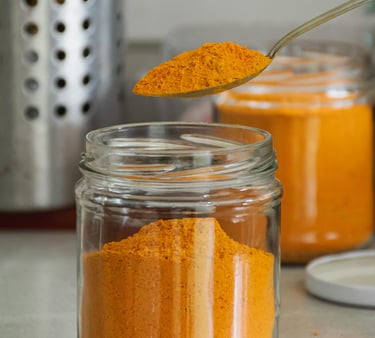

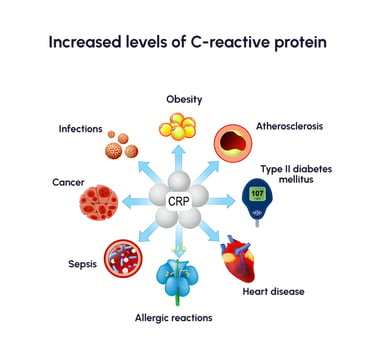

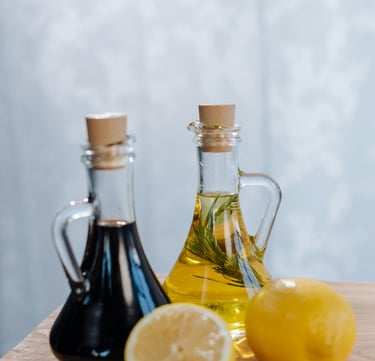

The Network Effect: How Inflammation Fuels Other Hallmarks
Inflammaging doesn't act alone; it's a master driver that worsens other aging processes:
The Senescence Link: The SASP from zombie cells is a primary engine of inflammaging.
The Mitochondria Link: The oxidative stress from dysfunctional mitochondria triggers inflammation. In turn, a highly inflammatory environment damages mitochondria, creating a vicious cycle.
The Gut Dysbiosis Link: An unhealthy microbiome is a major source of chronic, body-wide inflammation.
The Horizon: The Next Generation of Senolytics
The future of managing inflammation is about precision. Researchers are developing drugs that can block specific inflammatory pathways, like the NLRP3 inflammasome, without suppressing the entire immune system. There is also a growing focus on Specialized Pro-resolving Mediators (SPMs) - compounds derived from omega-3s that don't just block inflammation but actively help the body resolve it and return to balance.
Key Takeaways:
Chronic, low-grade inflammation, or "inflammaging," is a central driver of most age-related diseases.
You can easily measure your baseline inflammation with a simple blood test for hs-CRP.
An anti-inflammatory diet, regular exercise, quality sleep, and stress management are the most powerful tools to fight inflammaging.
Targeted supplements like Omega-3s and Curcumin can provide additional, powerful support.
Controlling inflammation positively impacts nearly every other Hallmark of Aging.
The Road Ahead
We are now unwrapping each Hallmark in great detail, exploring what it is, how to measure it, and how to improve it. Once we have the foundations in place, I cannot wait to share which supplement brands I have tried and what I like about them. But first, let’s build the knowledge so that your decisions can be better informed by the one person who knows your body best: you.
Controlling your inflammation isn't just about managing one Hallmark of Aging; it's about turning off the master switch that accelerates nearly all the others.
Important Terms
Inflammaging - A term for the chronic, low-grade, systemic inflammation that develops with age.
hs-CRP (High-sensitivity C-reactive protein) - The primary blood marker used to measure levels of systemic inflammation.
Cytokines - Small proteins that act as messengers in the immune system, some of which are pro-inflammatory.
Polyphenols - Beneficial compounds found in plant foods that have antioxidant and anti-inflammatory properties.
Curcumin - The active anti-inflammatory compound found in the spice turmeric.
Omega-3s - A type of essential fatty acid, found in fatty fish, that is powerfully anti-inflammatory.


References
Ammon, H. P. T. (2016). Boswellic Acids and Their Role in Chronic Inflammatory Diseases. Advances in Experimental Medicine and Biology, 928, 291–327. https://doi.org/10.1007/978-3-319-41334-1_13
Calder, P. C. (2017). Omega-3 fatty acids and inflammatory processes: from molecules to man. Biochemical Society Transactions, 45(5), 1105–1115. https://doi.org/10.1042/BST20160474
Ferrucci, L., & Fabbri, E. (2018). Inflammageing: chronic inflammation in ageing, cardiovascular disease, and frailty. Nature Reviews Cardiology, 15(9), 505–522
Franceschi, C., Garagnani, P., Parini, P., Giuliani, C., & Santoro, A. (2018). Inflammaging: a new immune-metabolic viewpoint for age-related diseases. Nature Reviews Endocrinology, 14(10), 576–590. https://doi.org/10.1038/s41574-018-0059-4
Hewlings, S. J., & Kalman, D. S. (2017). Curcumin: A Review of Its Effects on Human Health. Foods, 6(10), 92. https://doi.org/10.3390/foods6100092
López-Otín, C., Blasco, M. A., Kroemer, G., Piacentini, M., & Piva, R. (2023). Hallmarks of aging: An expanding universe. Cell, 186(2), 243–278. https://doi.org/10.1016/j.cell.2022.11.001
Mullington, J. M., Simpson, N. S., Meier-Ewert, H. K., & Haack, M. (2010). Sleep loss and inflammation. Best Practice & Research. Clinical Endocrinology & Metabolism, 24(5), 775–784. https://doi.org/10.1016/j.beem.2010.08.014
Rea, I. M., Gibson, D. S., McGilligan, V., McNerlan, S. E., Alexander, H. D., & Ross, O. A. (2018). Age and Age-Related Diseases: Role of Inflammation Triggers and Cytokines. Frontiers in Immunology, 9, 586. https://doi.org/10.3389/fimmu.2018.00586
Explore
Discover insights on longevity and wellness.
lONGEVITY EXPLAINED
© 2025. All rights reserved.
Terms and conditions
